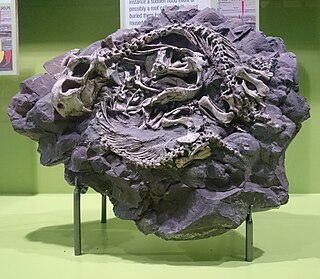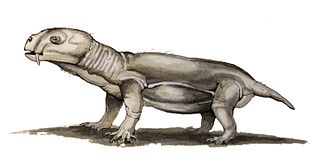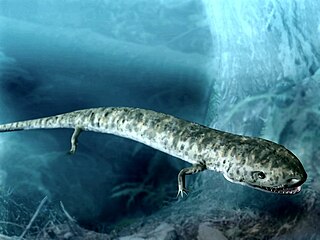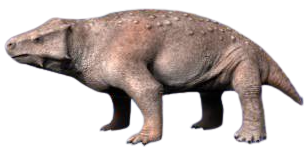
Dicynodontia is an extinct clade of anomodonts, an extinct type of non-mammalian therapsid. Dicynodonts were herbivorous animals with a pair of tusks, hence their name, which means 'two dog tooth'. Members of the group possessed a horny, typically toothless beak, unique amongst all synapsids. Dicynodonts first appeared in Southern Pangaea during the mid-Permian, ca. 270–260 million years ago, and became globally distributed and the dominant herbivorous animals in the Late Permian, ca. 260–252 Mya. They were devastated by the end-Permian Extinction that wiped out most other therapsids ca. 252 Mya. They rebounded during the Triassic but died out towards the end of that period. They were the most successful and diverse of the non-mammalian therapsids, with over 70 genera known, varying from rat-sized burrowers to elephant-sized browsers.

Milleretta is an extinct genus of millerettid parareptile from the Late Permian of South Africa. Fossils have been found in the Balfour Formation. Milleretta was a moderately sized, lizard-like animal, about 60 centimetres (24 in) in length. It was probably insectivorous. Its only known species is Milleretta rubidgei, making Milleretta a monospecific genus.

Trematopidae is a family of dissorophoid temnospondyl spanning the late Carboniferous to the early Permian. Together with Dissorophidae, the family forms Olsoniformes, a clade comprising the medium-large terrestrial dissorophoids. Trematopids are known from numerous localities in North America, primarily in New Mexico, Oklahoma, and Texas, and from the Bromacker quarry in Germany.

Trimerorhachis is an extinct genus of dvinosaurian temnospondyl within the family Trimerorhachidae. It is known from the Early Permian of the southwestern United States, with most fossil specimens having been found in the Texas Red Beds. The type species of Trimerorhachis, T. insignis, was named by American paleontologist Edward Drinker Cope in 1878. Cope named a second species from Texas, T. mesops, in 1896. The species T. rogersi and T. greggi are also from Texas, and the species T. sandovalensis is from New Mexico.

Eosimops is an extinct genus of pylaecephalid dicynodonts. They were small synapsids superficially resembling modern mammals. Eosimops is known from several skull specimens, as well as one complete skeleton. Eosimops lived during the Middle Permian of South Africa.
Tupilakosauridae is an extinct family of dvinosaurian temnospondyls. It contains the genera Slaugenhopia, Thabanchuia, Tupilakosaurus, and possibly Kourerpeton. Tupilakosaurs are known from Texas, Greenland, Russia, and France. The earliest tupilakosaur, Slaugenhopia, is Early Permian in age while the latest known tupilakosaurs are Early Triassic in age. Derived tupilakosaurs possess embolomerous centra in their vertebrae, which are diplospondylous. They also have a deep notch in the pterygoid bone of the palate. Tupilakosaurs were aquatic, and used an undulatory mode of swimming much like that of eels.

Lystrosauridae is a family of dicynodont therapsids from the Permian and Triassic time periods. It includes two genera, Lystrosaurus and Kwazulusaurus. Kwazulusaurus includes a single species, K. shakai, from the Late Permian of South Africa and Lystrosaurus includes many species from the Late Permian and Early Triassic of South Africa, India, and Antarctica.

Gymnarthridae is an extinct family of tuditanomorph microsaurs. Gymnarthrids are known from Europe and North America and existed from the Late Carboniferous through the Early Permian. Remains have been found from the Czech Republic, Nova Scotia, Illinois, Texas, and Oklahoma.

Bobasatraniiformes is an extinct order of durophagous ray-finned fish that existed from the late Permian to the Middle Triassic in both marine and freshwater environments. The order includes two families: Bobasatraniidae, with the genera Bobasatrania, Ebenaqua, and Ecrinesomus, and Dorypteridae, comprising only the genus Dorypterus (monotypy). Bobasatraniiformes had a somewhat global distribution; fossils are found in Africa (Madagascar), Asia (Pakistan), Australia, Europe, and North America.
Phaanthosaurus is an extinct genus of basal procolophonid parareptile from early Triassic deposits of Nizhnii Novgorod, Russian Federation. It is known from the holotype PIN 1025/1, a mandible. It was collected from Vetluga River, Spasskoe village and referred to the Vokhmian terrestrial horizon of the Vokhma Formation. It was first named by P. K. Chudinov and B. P. Vjushkov in 1956 and the type species is Phaanthosaurus ignatjevi.

Sinophoneus is an extinct genus of carnivorous dinocephalian therapsid belonging to the family Anteosauridae. It lived 272 to 270 million years ago at the beginning of the Middle Permian in what is now the Gansu Province in northern China. It is known by a skull of an adult individual, as well as by many skulls of juvenile specimens. The latter were first considered as belonging to a different animal, named Stenocybus, before being reinterpreted as immature Sinophoneus. Sinophoneus shows a combination of characters present in other anteosaurs. Its bulbous profile snout and external nostrils located in front of the canine are reminiscent of the basal anteosaur Archaeosyodon, while its massive transerse pterygoids processes with enlarged distal ends are more similar to the more derived anteosaurs Anteosaurus and Titanophoneus. First phylogenetic analyzes identified Sinophoneus as the most basal Anteosaurinae. A more recent analysis positioned it outside the Anteosaurinae and Syodontinae subclades, and recovers it as the most basal Anteosauridae.

Paleontology in Oklahoma refers to paleontological research occurring within or conducted by people from the U.S. state of Oklahoma. Oklahoma has a rich fossil record spanning all three eras of the Phanerozoic Eon. Oklahoma is the best source of Pennsylvanian fossils in the United States due to having an exceptionally complete geologic record of the epoch. From the Cambrian to the Devonian, all of Oklahoma was covered by a sea that would come to be home to creatures like brachiopods, bryozoans, graptolites and trilobites. During the Carboniferous, an expanse of coastal deltaic swamps formed in areas of the state where early tetrapods would leave behind footprints that would later fossilize. The sea withdrew altogether during the Permian period. Oklahoma was home a variety of insects as well as early amphibians and reptiles. Oklahoma stayed dry for most of the Mesozoic. During the Late Triassic, carnivorous dinosaurs left behind footprints that would later fossilize. During the Cretaceous, however, the state was mostly covered by the Western Interior Seaway, which was home to huge ammonites and other marine invertebrates. During the Cenozoic, Oklahoma became home to creatures like bison, camels, creodonts, and horses. During the Ice Age, the state was home to mammoths and mastodons. Local Native Americans are known to have used fossils for medicinal purposes. The Jurassic dinosaur Saurophaganax maximus is the Oklahoma state fossil.
Parasumina is an extinct genus of anomodont known from the late Capitanian age at the end of the middle Permian period of European Russia. The type and only species is Parasuminia ivakhnenkoi. It was closely related to Suminia, another Russian anomodont, and was named for its resemblance. Little is known about Parasuminia as the only fossils are of fragmentary pieces of the skull and jaw, but the known remains suggest that its head and jaws were deeper and more robust than those of Suminia, and with shorter, stouter teeth. However, despite these differences they appear to have been similar animals with a similarly complex method of processing vegetation.
The Micropholidae are an extinct family of dissorophoid euskelian temnospondyls known from Late Carboniferous to Early Triassic strata in the United States and South Africa.

Parasaurus is a genus of pareiasaur known from fossils collected in the Kupferschiefer in Germany, dating to the Late Permian (Wuchiapingian). The type species, Parasaurus geinitzi, described by Hermann von Meyer in 1857, was the first pareiasaur ever described. The seven known specimens were redescribed in 2008.
Bradyina is an extinct genus of fusulinid belonging to the family Bradyinidae. Specimens of the genus have been found in Carboniferous to Permian beds in Europe, Asia, and North America. The genus has been used as an index fossil in China.
Eostaffella is an extinct genus of fusulinid belonging to the family Eostaffellidae. Specimens of the genus have been found in Carboniferous to Permian beds in Europe, Asia, and North America.

Amphissites is an extinct genus of ostracod belonging to the suborder Beyrichicopina and family Amphissitinae. Species belonging to the genus lived from the Devonian to the Permian in Europe, North America, Australia, and east Asia. The genus were likely deposit-feeders, and may have survived briefly into the Triassic.

Aurikirkbya is an extinct genus of ostracod belonging to the suborder Beyrichicopina and family Kirkbyidae. It is found in Pennsylvanian to Triassic beds in North America, east Asia, southwest Asia, and Europe.

Anisopyge is an extinct genus of trilobite belonging to the order Proetida and family Phillipsiidae. Specimens have been found in Permian beds in North and Central America.













